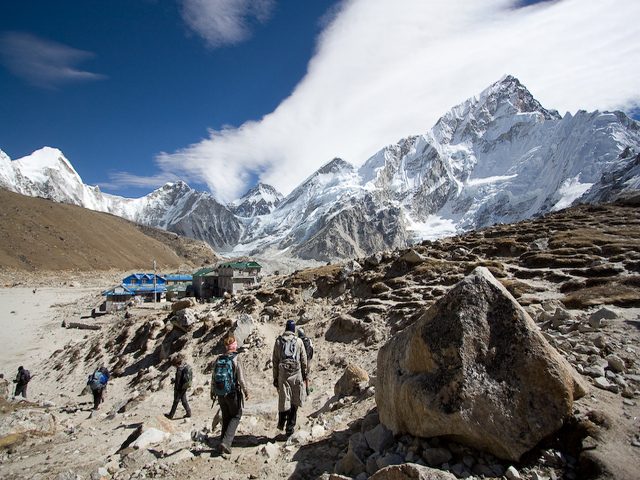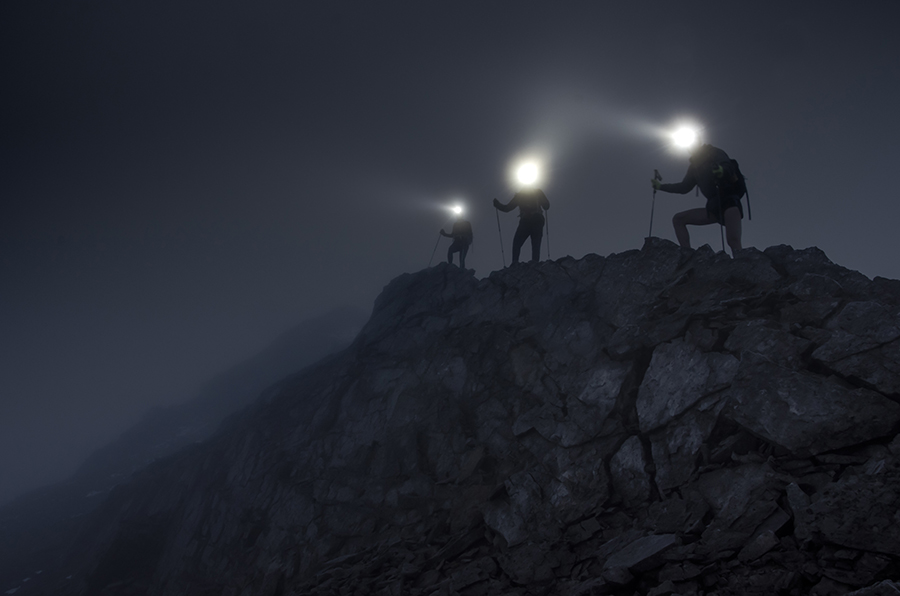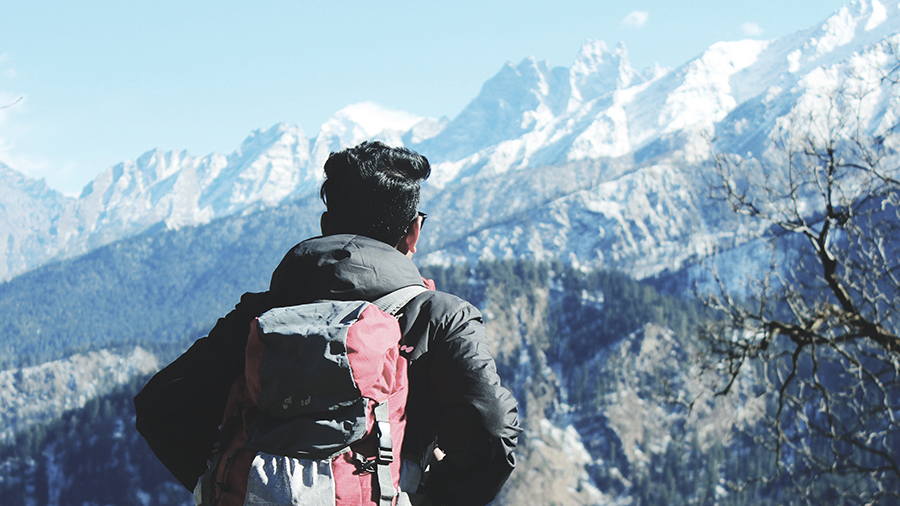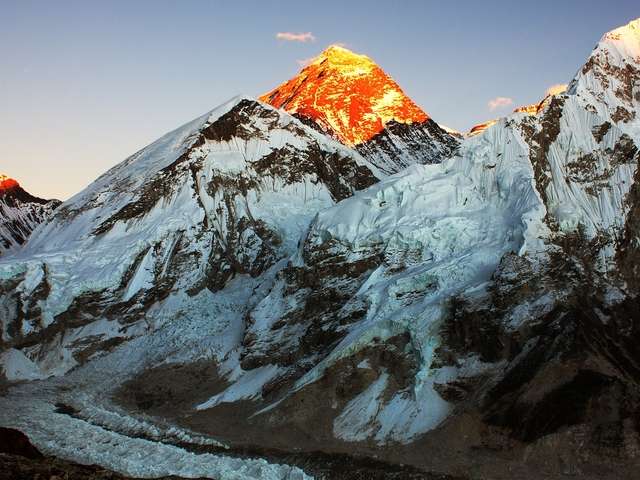
Packing for Everest Base Camp can be stressful. There are strict weight restrictions on the flight from Kathmandu to Lukla, but you also want to be sure to pack all the essentials for the trail. In this article, we share our complete Everest Base Camp packing list from years of guiding thousands of treks to and from Everest Base Camp
Moisture-Wicking T-Shirts
Bring 2 long-sleeved and one short-sleeved moisture-wicking t-shirt for your base layer. Look for Capilene or Merino Wool as the fabric. Avoid cotton or cotton blends. This is because cotton absorbs moisture, making the fabric wet, heavy—and cold. Lower elevations may be warm enough that you’d rather wear the short-sleeved shirt, where you’ll want the long-sleeve shirt in the colder weather.
Heavy Fleece Jacket
Your fleece jacket will act as your middle layer, to be worn over your moisture-wicking base layer and under your outer shell. It’s also a good idea to find a jacket that is easy to zip and unzip—this way if it’s too warm to wear the jacket zipped but too cold to take it off all the way, you can unzip the jacket for a good balance of cooling and warming.
Warm Outer Core Layer
You will also want to pack a warm outer core layer for Everest Base Camp. Adventure Hero rents this layer to clients—just let your adventure expert know ahead of your trek that you’d like one! This is also a good layer to purchase in Kathmandu, as you can often find inexpensive, good-quality trekking gear. Make sure to read our guide on buying cheap trekking gear in Kathmandu to ensure you know what to look for.
Waterproof Jacket with Hood
A breathable waterproof jacket should be your outer shell layer. This is the layer that is meant to protect you from the elements. The best material for this jacket is Gortex, which is both breathable and waterproof. A nylon jacket or poncho can be a less expensive alternative; however, this fabric tends to trap moisture and make it more difficult for your body to regulate temperature.

Windbreaker
You may want to bring a windbreaker in addition to your waterproof jacket. This is best used for dry days when you don’t need heavier waterproof jackets. The shell will protect against cold air penetrating your layers.
Rain Poncho
In case your jacket isn’t as waterproof as you’d hoped or in a case where you need extra protection, carry a rain poncho that can fit over yourself and your backpack. These are small and light—and can make a big difference in keeping you and your gear dry, especially during the rainy season.
Fleece Pants
Bring a pair of warm pants to wear under your trekking pants when packing for Everest Base Camp. Fleece pants work well, as do thermals or lined yoga pants. This is your insulating layer.
Trekking Pants
Your trekking pants are the protective layer over the insulating fleece layer. This is the layer that takes the brunt of the elements, protecting you and your insulating layer from dust, dirt, and brush. If you’re hiking in the cold and wet off-season, it can be a good idea to invest in waterproof pants.
Hiking Shorts
During the warmer trekking season, you may find that the lower elevations are warm enough to wear hiking shorts instead of pants.
Hiking Socks
Merino wool socks are usually considered the best socks to pack for Everest Base Camp. That’s because merino wool protects your feet, dries quickly, does not absorb odors, and is durable. Investing in good hiking socks can be the difference between a comfortable trek and blisters. You may also consider bringing light sock liners as these can help protect against blisters. Adventure Hero recommends bringing a fresh pair for every day of the hike.
Warm Thermal Socks
You’ll want to have warm thermal socks packed when you’re sleeping in tea houses along Everest Base Camp. It can be nice to change out of your dirty hiking socks to put on some warm thermal socks as you rest for the evening. If you bring along wipes (mentioned later in this list) then you can even do a quick “trail shower” before you put these on for the evening.
Long Underwear
Just like the warm thermal socks, clean long underwear is a must-have to pack for Everest Base Camp as you’re resting in tea houses. If you’re planning on hiking in thermals, this pair should be separate from any pair you wear on the trail. You want this long underwear to be dry and fresh for bed each night for optimal warmth.
Undergarments
Bring enough undergarments—underwear, sports bras, etc. for your full trek. For underwear, we recommend a fresh pair each day, though sports bras can usually be worn more than one day. Make sure your undergarments are moisture-wicking (not cotton) for comfort and dryness.

Hiking Boots
We recommend packing hiking boots with ankle support for your Everest Base Camp trek. While the trek is not especially rocky, it’s better to have this extra support than to risk a turned ankle ruining your trek. However, if you’ve been training in hiking boots or shoes without ankle support, you can consider sticking with those. Make sure whatever hiking boots you choose for your trek are well-broken-in and don’t pinch or rub.
Tennis Shoes or Hard-Soled Slippers
After a long day of trekking to Everest Base Camp, you’ll thank yourself if you’ve packed some comfortable tennis shoes or camp shoes for the end of the day. When you’re settling into the tea houses each night, you can take off your bulky hiking boots and swap them for these more comfortable shoes for a nice change of pace.
Insulated Mittens or Gloves
Keep your hands warm on the Everest Base Camp trek with insulated mittens or gloves. Make sure to bring high-quality glove liners as well. The liners are good for wearing when it’s not quite cold enough for your insulated gloves, to keep your hands protected when you need to untie or unzip, and as an extra layer when it’s especially cold outside.
Sunglasses
Protect your eyes from the glare off the snow with sunglasses. There is a higher risk of UV damage at higher elevations, making sunglasses important.
Broad-Brimmed Hat
The sun reflects off the snow as you trek along Everest Base Camp, which can cause some painful sunburns if you’re not being conscientious about sun protection. Sunglasses, a broad-brimmed hat, a neck gaiter, and sunscreen are all must-haves for Everest Base Camp.
Neck Gaiter
Protect your neck from sunburns with a neck gaiter such as a BUFF. You can also wear a bandana if you prefer.
Wool Hat
Packing a wool hat or balaclava is important for Everest Base Camp to prevent additional heat loss and to protect sensitive ears from cold.
Gaiters
Gaiters cover from your ankle to your calves and are useful for preventing snow, dust, rocks, dirt, and mud from getting into your shoes. Gaiters are pretty essential to pack for Everest Base Camp if you’re hiking between December and February; however, they can be useful at all times on the trail.
Sleeping Bag
Although you’re staying in tea houses, these tea houses do not have warm bedding for your sleep each night. That’s why it’s important to pack a warm sleeping bag for Everest Base Camp. Look for a sleeping bag that is rated to at 18°C/0°F. These sleeping bags are available for rental if you are trekking to Everest Base Camp with Adventure Hero. You’ll also want to bring a stuff-sack to put your sleeping bag in to save space in your duffle bag.
Water Bottles or Hydration Bladder
Hydration is very important along the trek. Drinking plenty of water will help stave off symptoms of dehydration, keep you performing at your peak, and will help prevent altitude sickness. Bring reusable water bottles on the trail or a hydration bladder. Your guide will point you in the right direction to fill these up at your various stops.
Lightweight Water Filter or Iodine Tablets
You’ll also want to be sure to pack a lightweight water filter or iodine tablets for when you refill your water along the Everest Base Camp trail. This is an important step in preventing waterborne illnesses.
Trekking Poles
While trekking poles aren’t required, they’re recommended—especially if you haven’t done a similar trip without them before. Trekking poles will help you maintain your stability on a trail. These are especially useful on uphill or downhill grades to help give you anchor points. Hiking with trekking poles also helps prevent your hands from swelling as you hike.

Headlamp With Extra Batteries
You’ll want to pack a headlamp for your Everest Base Camp trek. While you’ll mainly be hiking during the day (except for the early morning Kalapathar hike on Day 10 of the Adventure Hero Everest Base Camp trek which takes you to see the fiery sunrise over Mt. Everest), a headlamp is also important for making trips to the restroom in the middle of the night.
Travel Pillow or Pillowcase
While tea houses work hard to keep their rooms clean for travelers, it’s more difficult to maintain a high standard of cleanliness the further up you get on a mountain. For this reason, it’s usually a good idea to bring a travel pillow that you can use instead of the pillow provided or to bring a pillowcase you can use to cover the pillows provided at the tea houses.
Camera
Don’t forget your camera! We’re always surprised how many people embark on the gorgeous, once-in-a-lifetime Everest Base Camp journey but forget to pack a camera. Bring extra batteries and memory cards, and keep the batteries close to your person when you sleep—batteries drain more quickly in the cold.
Snacks
Trekking for 6-8 hours a day is hard work. Make sure you pack plenty of snacks to stock up your daypack before each day. Look for a good combination of protein and carbs for longer-lasting, well-balanced energy, and pack a few of your favorite treats as well. While you’ll be able to purchase some snacks along the trail, they’re often overpriced and may not be exactly what you’re used to. Besides, there’s nothing like your favorite chocolate bar as a treat a few days into your journey.
Thermos
In the cold air of the Himalayas, tea can be a great way to warm up. Bring a thermos to fill with hot tea as you pass tea houses.
Rehydration Gels, Powders, or Tablets
Rehydration gels, powders, or tablets can help restore your electrolytes without requiring you to carry heavy sports drinks up the mountain.
Sunscreen
Sun protection is important to pack as you trek up to Everest Base Camp. Sunscreen is a must-have for protecting your face and any other exposed skin as you trek at high altitude. You’ll also want to bring lip balm with sunscreen.
Toilet Paper
If you ask a dozen people whether you need to pack toilet paper for the Everest Base Camp trek, you’ll get half who say you should bring extra and half who say you shouldn’t bother. To be on the safe side, pack toilet paper to keep in your daypack—and a little extra for your duffle bag.

Medicines
Pack with you any prescription prescriptions or supplements you will need on your trek as well as some basic first aid medicines such as Advil or ibuprofen, Diamox (for altitude sickness), and antibiotics such as Cipro for traveler’s diarrhea.
Blister/Rash Prevention & Treatment
Blisters and rashes can quickly create significant discomfort on the trail. Prevent blisters by using sock liners or an anti-chafe balm such as body glide. Also bring moleskin, medical tape, and/or duct tape to prevent blisters as soon as you feel them coming on. It’s also a good idea to bring a small tube of diaper rash cream to treat rashes or chafing, should they occur.
Toiletries
Toiletries can add weight fast, so it’s important to be practical but judicious. We recommend soap, deodorant, a toothbrush and toothpaste, razor (as needed), shampoo, face lotion, hairbrush & hair ties (as needed), earplugs (for sleeping), and feminine hygiene products (as needed).
Wet Wipes & Hand Sanitizer
Wet wipes may become one of your best friends along the trail, as will hand sanitizer. It’s important to keep a high level of hygiene on the trail to prevent illness—no one wants to be fighting a stomach bug while hiking Everest Base Camp. Use wet wipes as a “trail shower” when showers aren’t available or when the air is too cold for you to bear the thought of having damp hair. Use hand sanitizer liberally before and between meals.
Portable Solar Charger
Since batteries die much more quickly at cold temperatures—and since recharging stations at tea houses can be very expensive—you may want to pack a portable solar charger or power bank for your Everest Base Camp trek.
Book & Playing Cards
While you’ll be exhausted as you settle into the tea houses after each day of trekking, you still will often find that you’ll have time to spend before you’re ready to sleep. A book and playing cards can help pass the time. Playing cards are also a great way to bond with other travelers as you swap card games.
Journal & Pen
You may want to pack a journal and pen to document your journey as you trek Everest Base Camp. For most people, this is a once-in-a-lifetime adventure, and you don’t want to forget it!
Important Documents
There are several important documents you will need to pack for your Everest Base Camp trek. This includes your passport, visa (which can be attained when you land in Kathmandu for $30 or $50 USD depending on how many days you are staying), travel insurance, and two passport-sized photos if you’re trekking in the Annapurna Region.
Money
Plan to bring at least $200-300 of cash with you while you’re on the trail. This will help with any incidentals such as forgotten toiletries, medication, or an insatiable craving for Pringles or other snacks. While there are occasional ATMs on the trail, they are almost always out of order. If you had a great time on your trek, your porters and guide will appreciate a tip, which is best given in Lukla at the end of the trek and before you fly back to Kathmandu.
What to Use to Pack Everything for Everest Base Camp
Now that you’ve gathered everything you need to pack for Everest Base Camp, what should you carry it all in? In most cases when you’re trekking Everest Base Camp—including trekking with Adventure Hero—you will only be responsible for carrying your daypack up the trail and porters will be in charge of carrying the rest of your gear packed in a duffle bag. This means you should have a duffle bag and a daypack for your trek.
Duffle Bag
Your duffle bag is what is used for carrying everything you will need at tea houses but will not need each day as you hike along the trail. This duffle bag will need to weigh 10kg (22lbs) or less when full for your flight from Kathmandu to Lukla. When you trek with Adventure Hero, we provide this duffle bag for you at the hotel before the trek. You may leave additional luggage at the hotel until you return. Make sure to bring locks for the luggage you leave behind as well as for the duffle bag the porters will carry—while we screen our porters and are confident in their honesty, we find bringing your own locks can give peace of mind along the trek.

Daypack
Your daypack is the bag you will carry on your back as you trek each day between tea houses. In this pack, you should carry your water, any medications you’ll need on the trail, snacks, a camera, and any other needs for the day. Look for a Daypack that is around 40L and fits well—you’ll want to wear it on at least a few practice hikes before Everest Base Camp to ensure it fits and is comfortable on the trail. It’s usually a good idea to make sure you also have a waterproof cover for your daypack in case rain or snow hits.
Stuff Sacks & Dry Bags
You will want to pack stuff sacks and dry bags in several sizes for your camp shoes and dirty, wet clothes along the trek. This will make sure your next day’s clothes and warm sleeping clothes do not get wet when they’re sitting in the same pack.
How Can We Help?
Do you have any questions about packing for Everest Base Camp or about this comprehensive packing list? Let us know! Our Adventure Specialists are happy to help.

















